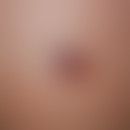Synonym(s)
DefinitionThis section has been translated automatically.
Very rare, non-scarring, blistering autoimmune disease from the pemphigoid group.
ClinicThis section has been translated automatically.
Clinically this non-scarring dermatosis does not differ substantially from other pemphigoids (see overview pemphigoid group). It is characterized by the occurrence of blisters and erosions in the skin (and mucous membrane?). Clinically significant is the association of the anti-type IV collagen pemphigoid with membranous glomerulonephritis.
You might also be interested in
Direct ImmunofluorescenceThis section has been translated automatically.
Linear IgG and C3 deposition at the dermo-epidermal junction. Type IV collagen, which is localized in the lamina densa, could be analyzed as antigen. Collagen type XVII (BP180) was shown to bind directly to collagen type IV in normal human keratinocytes and normal human oral keratinocytes (Kamaguchi M et al. 2019). If collagen type IVa (COL4A5) antibodies are detected, renal involvement must be expected (Sueki H et al. 2015).
Note(s)This section has been translated automatically.
Type IV collagen (Col 4) is a structural protein that binds to intermediate filaments. It is mainly found in the lamina densa of the basal membrane of the epidermis. It is important for the epidermal integrity of the basement membrane. Furthermore, this type of collagen is a component of the eye lens and the glomeruli of the nephron.
In humans collagen IV is encoded by 6 different genes:
- COL4A1
- COL4A2
- COL4A3
- COL4A4
- COL4A5
- COL4A6
Mutations lead to the following diseases: Alport syndrome, Goodpasture's syndrome, thin basement membrane nephropathy, recurrent corneal erosion dystrophy (ERED);
LiteratureThis section has been translated automatically.
- Buijsrogge JJ et al (2009) Antiplectin autoantibodies in subepidermal blistering diseases. Br J Dermatol 161:762-771.
- Chan LS (1997) Human skin basement membrane in health and in autoimmune diseases. Front Biosci 2:d343-52.
- Fania L et al (2018) Detection and characterization of IgG, IgE, and IgA autoantibodies in patients with bullous pemphigoid associated with dipeptidyl peptidase-4 inhibitors. J Am Acad Dermatol78:592-595.
- Georgi M et al (2001) Autoantigens of subepidermal bullous autoimmune dermatoses. Dermatologist 52:1079-1089
- Göbel M et al (2019) Management of bullous pemphigoid. Dermatologist 70:236-242.
- Kamaguchi M et al. (2019)The direct binding of collagen XVII and collagen IV is disrupted by pemphigoid autoantibodies.Lab Invest 99:48-57.
- McMillan JR et al (2007) Plectin defects in epidermolysis bullosa simplex with muscular dystrophy. Muscle Nerve 35:24-35
- Pardo RJ et al (1990) Location of basement membrane type IV collagen beneath subepidermal bullous diseases.J Cutan Pathol 17:336-341.
- Sueki H et al (2015) A case of subepidermal blistering disease with autoantibodies to multiple laminin subunits who developed later autoantibodies to alpha-5 chain of type IV collagen associated with membranous glomerulonephropathy. Acta Derm Venereol 95: 826-829.
Outgoing links (4)
Alport syndrome; Collagen type iv; Goodpasture's syndrome; Pemphigoid group (overview);Disclaimer
Please ask your physician for a reliable diagnosis. This website is only meant as a reference.




